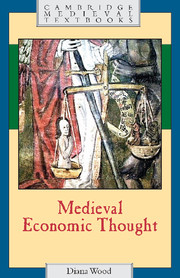Book contents
- Frontmatter
- Contents
- Preface
- List of abbreviations
- Introduction: problems, evidence, and background
- 1 Private property versus communal rights: the conflict of two laws
- 2 Wealth, beggary, and sufficiency
- 3 What is money?
- 4 Sovereign concerns: weights, measures, and coinage
- 5 The mercantile system
- 6 The just price and the just wage
- 7 The nature of usury: the usurer as winner
- 8 The theory of interest: the usurer as loser
- Conclusion
- Appendix: Notes on the main writers and anonymous works mentioned in the text
- Glossary of terms
- Select bibliography
- Index
- Cambridge Medieval Textbooks
Introduction: problems, evidence, and background
Published online by Cambridge University Press: 05 June 2012
- Frontmatter
- Contents
- Preface
- List of abbreviations
- Introduction: problems, evidence, and background
- 1 Private property versus communal rights: the conflict of two laws
- 2 Wealth, beggary, and sufficiency
- 3 What is money?
- 4 Sovereign concerns: weights, measures, and coinage
- 5 The mercantile system
- 6 The just price and the just wage
- 7 The nature of usury: the usurer as winner
- 8 The theory of interest: the usurer as loser
- Conclusion
- Appendix: Notes on the main writers and anonymous works mentioned in the text
- Glossary of terms
- Select bibliography
- Index
- Cambridge Medieval Textbooks
Summary
There was once a hungry ass who was standing between two heaps of hay. Each heap was equal in every respect. Because the ass could not decide between the two, he starved to death. This famous story, wrongly attributed to the fourteenth-century philosopher John Buridan, and known as ‘Buridan's Ass’, was about the difficulty of making moral decisions, but it can also serve as a useful introduction to medieval economic thought.
The Franciscan John Buridan was a scholastic, a product of the University of Paris, primarily a philosopher and a commentator on the works of Aristotle, but also a mathematician and a theologian. During the medieval period most economic ideas were framed by such people. The medieval world was not one of econometrics and global markets, but one of ‘theological economy’. Economics as a discrete discipline did not exist, so that, strictly speaking, ‘Medieval Economic Thought’ is a misnomer. All thought, whether political, philosophical, legal, scientific, or economic would have been regarded as an aspect of theology. This means that much economic thought has to be harvested from theological works, written by scholastics, many of whom were mendicant friars. Not surprisingly, medieval economic ideas are heavily imbued with questions of ethics and morality, with the motives rather than the mechanics of economic life. It was not until the early Renaissance period that people started to reflect on specifically economic topics.
- Type
- Chapter
- Information
- Medieval Economic Thought , pp. 1 - 16Publisher: Cambridge University PressPrint publication year: 2002



